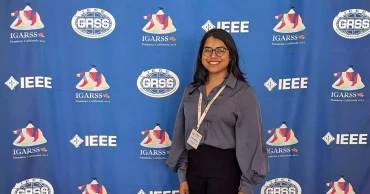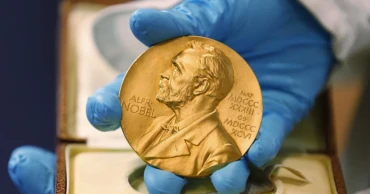scientist
Scientists develop most refined chimpanzee brain atlas
A collaborative team of scientists from China and other countries has mapped the most refined chimpanzee brain atlas to date, providing novel insights into the evolution of the human brain, the Science and Technology Daily reported on Tuesday.
The study was published in the journal The Innovation.
Chimpanzees are one of humans' closest living relatives. Despite having a brain that is only about one-third the size of a human's, they share many similarities with humans in neuroanatomy and cognitive functions, making them an important comparison point for understanding human brain evolution.
Blue Origin attempts rocket launch again after last-minute delay
"However, a major challenge in current cross-species neuroscience research is the absence of standardized brain reference systems with biological significance," said Fan Lingzhong, corresponding author of the study and a researcher at the Institute of Automation under the Chinese Academy of Sciences.
Based on the concept of using brain connectivity information to construct brain atlases, researchers have successfully developed the Chimpanzee Brainnetome Atlas (ChimpBNA).
Leveraging this new resource, they found substantial differences in connectivity patterns between chimpanzees and humans across most association cortices, highlighting more complex and nuanced connectivity changes in brain evolution than previously understood.
Scientists solve 200-year-old mystery of the Sun’s turning blue
Fan said that the ChimpBNA will serve as a valuable resource for neuroscience research and offer new insights into the unique characteristics of the human brain.
"Going forward, we will continue to expand the application of cross-species brain atlases to enhance their value in understanding the evolution of the nervous system," Fan added.
11 months ago
14-year-old wins award for developing soap to treat skin cancer
A 14-year-old school student has been termed "America's top young scientist" for creating a bar of soap that may be effective in the treatment of melanoma, a skin cancer that affects roughly 100,000 individuals in the United States each year and kills approximately 8,000.
Heman Bekele, a ninth-grader from Annandale, Virginia, was selected over nine other finalists for the award, reports The Guardian.
Also read: The next big advance in cancer treatment could be a vaccine
“Curing cancer, one bar of soap at a time,” he said in his submission. “I have always been interested in biology and technology, and this challenge gave me the perfect platform to showcase my ideas,” he added.
He submitted his soap idea, "skin cancer treating soap," produced from ingredients that may reawaken dendritic cells that defend human skin, allowing them to combat cancer cells. Bekele stated in a video for the 3M Young Scientist Challenge that he believes "that young minds can make a positive impact on the world," the report said.
Also read: New AI model can accurately diagnose cancer: Study
Bekele's inspiration stemmed from his childhood in Ethiopia, where he saw people continually labouring under the blazing sun. “I wanted to make my idea something that not only was great in terms of science but also could be accessible to as many people as possible.”
Skin cancer is quite common, according to the American Cancer Society, with melanoma accounting for only 1 percent, yet causing the bulk of skin cancer deaths, the report also said.
Also read; Ancient viruses can help fight cancer, scientists say
According to the association, melanoma rates have been significantly increasing over the last few decades, particularly among women over 50, and it is more than 20 times more prevalent in white people than in black people. At the same time, owing to breakthroughs in therapy, melanoma death rates have decreased over the last decade.
After receiving the award, Bekele told the judging panel that he hoped the soap would become a "symbol of hope, accessibility, and a world where skin cancer treatment is within everyone's reach."
2 years ago
Bangladeshi imaging scientist Nayma shines on global stage
Nayma Binte Nur, a Bangladeshi imaging scientist who is affiliated with the Rochester Institute of Technology (RIT), is having her moment of glory in the global scientific community.
Nayma’s expertise lies in hyperspectral remote sensing and radiative transfer modeling, sophisticated techniques allowing her to unravel Earth’s systems’ complexities. In simple terms, she’s decoding the mysteries of the planet by studying how light interacts with its surface.
3 scientists win Nobel Prize in physics for looking at electrons in atoms during split seconds
One of Nayma's key focuses is soil moisture, a crucial factor influencing a wide range of ecological systems and affecting everything from agriculture to flood forecasts. Using advanced imaging methods, Nayma accurately determines soil moisture levels and extends her findings across vast areas using satellite imagery, showcasing the broad applicability of her work.
This ground-breaking approach has garnered the attention of prestigious scientific organizations, including NASA. In preparation for their upcoming Surface Biology and Geology (SBG) mission, NASA has highlighted Nayma’s work in a special collection, underscoring its potential influence.
ISRO Chandrayaan-3: 9 Women Scientists Who Led India’s Moon Landing
Nayma’s exceptional research does not end with NASA’s SBG mission; it has been showcased at prominent events hosted by NASA’s Jet Propulsion Laboratory and Planet Labs PBC. The scientific community commended her for her contributions and unique skill set, which are poised to drive significant breakthroughs, particularly in using light to reveal intricate details about organic matter in soil across extensive geographic regions.
Scientists board India’s research vessel ‘Sagar Nidhi’ for 35-day expedition
Nayma’s educational journey included an Electrical and Electronic Engineering degree from Khulna University of Engineering and Technology (KUET), enriched by advanced mathematics studies at Jahangirnagar University, which provided a sturdy foundation for her forays into imaging science.
2 years ago
Dr Gawsia and Dr Senjuti from Bangladesh among top 100 Asian scientists
Two Bangladeshi scientists have made it to the 2023 list of the "best and brightest" 100 Asian scientists for their contribution to research.
Child Health Research Foundation’s Dr Senjuti Saha and Dhaka University’s Dr Gawsia Wahidunnessa Chowdhury have been included in the eighth edition of the list published by Singapore-based magazine Asian Scientist.
This year’s list includes researchers and inventors from across a range of scientific disciplines for their groundbreaking achievements to transform our world -- from understanding glacial cycles and structural geology to advancing space exploration.
Also read: The ecosystem engineers that can filter Dhanmondi Lake’s water within 21 hours
“Asia’s researchers continue to dream big and serve marginalized communities. Pushing the boundaries of the unknown, the awardees, with the help of their teams, accomplished huge successes,” the Asian Scientist Magazine said in a press release.
Dr Gawsia Wahidunnessa Chowdhury has been included in the list for her contribution in the field of sustainability.
Dr Chowdhury is a professor of zoology at the University of Dhaka. She obtained her PhD in zoology (wetland ecology) from the University of Cambridge. She is a board member of the internationally renowned conservation organization WildTeam. WildTeam works to protect the rapidly disappearing natural assets of Bangladesh.
Also read: OWSD-Elsevier Foundation Award: Bangladesh's Gawsia among top women climate scientists
Dr Chowdhury won the OWSD-Elsevier Foundation Award in 2022 for her contributions to conserving aquatic ecosystems and vulnerable species in Bangladesh. She focuses on the risk of plastic pollution in the country’s waterways. She is also empowering women from poor and marginalized communities to turn discarded fishing nets into products such as carpets to help create alternative sources of income for women while protecting aquatic habitats.
Meanwhile, Dr Senjuti Saha, one of the leading young scientists in Bangladesh who has been championing the cause of equity in global health research, has been included in the list for her contribution to life sciences.
She was the first in the world to show that the chikungunya virus could cross the blood-brain barrier and cause meningitis in Bangladeshi children.
Also read: Bangladeshi scientist Senjuti Saha made member of WHO board
She has won multiple domestic and international awards for her contribution to medical science research including Women of Inspiration 2021 Award by Junior Chamber International, Bangladesh and Webby Award in 2020 for Infectious Disease Detectives (with Chan Zuckerberg Initiative).
Dr Saha is also a member of the Polio Transition Independent Monitoring Board (TIMB), created by the Global Polio Eradication Initiative led by the World Health Organization.
Scientists from China, India, Malaysia, Pakistan, Singapore, Japan, South Korea, the Philippines, Hong Kong, Sri Lanka, Indonesia, Thailand and Vietnam have also secured their place on the prestigious list.
Also read: 13 get 'Woman of Inspiration Award 2021'
2 years ago
Stephen Hawkings: 10 interesting facts about the great scientist
Stephen Hawking was a world-renowned theoretical physicist and cosmologist known for his contributions to the study of black holes and the origin of the universe. Let's take a look at life, work, and surprising facts about Stephen Hawkings, one of the greatest scientists in the world.
At a Glance: Life and Work of Stephen Hawking
Stephen Hawking was born on January 8, 1942, in Oxford, England, to Frank and Isobel Eileen Hawking and showed an early aptitude for mathematics and science. Hawking attended University College, Oxford, and later received his Ph.D. in applied mathematics and theoretical physics from the University of Cambridge, specializing in general relativity and cosmology.
Despite being diagnosed with motor neuron disease (also known as Lou Gehrig’s disease) at the age of 21, Hawking remained active in his research and continued to make significant contributions to the field of physics. He developed a theory about the origin of the universe, known as the “Big Bang” theory, and made significant contributions to the black holes study and their properties.
Read More: Top 11 Major Medical Science Innovations in 2022
Hawking was also known for his work on quantum-theory research into the origin of the universe. He also made significant contributions to the study of quantum mechanics and the unification of physical laws.
In addition to his scientific work, Hawking was also a popular science communicator, writing numerous books on physics and cosmology that were aimed at a general audience. His book “A Brief History of Time” became a best-seller and helped to bring the concepts of physics to a wider audience.
Hawking received numerous accolades for his work, including the Presidential Medal of Freedom, America’s highest civilian honor, in 2009. He was a Fellow of the Royal Society and held professorships at the University of Cambridge and the California Institute of Technology. Hawking passed away on March 14, 2018, at the age of 76. Despite his physical limitations, he remained active in his research and continued to make important contributions to the field of physics until the end of his life.
Read More: Top 10 Most Exciting Innovations of 2022 in Technology.
2 years ago
Top 5 Inventions of Scientist Isaac Newton
Sir Isaac Newton was one of the the greatest scientist in the world. He did groundbreaking research and discoveries regarding the laws of motion, characteristics of light, gravitational force, calculus, orbital cannon, etc. Newton has numerous additional innovations that aid in the modernization of civilizations. Let's take a look at the 5 most remarkable inventions and discoveries of the great scientist Isaac Newton.
At a Glance: Life of Sir Isaac Newton
Isaac Newton was born at Woolsthorpe, Lincolnshire, England, on January 4, 1643. After his mother remarried, Newton spent the most of his early years with his maternal grandmother. His father had died three months before to his birth. A unsuccessful effort to make him become a farmer halted his schooling, and he attended the King's School in Grantham before enrolling in 1661 at the University of Cambridge's Trinity College.
Newton studied a classical curriculum at Cambridge, but he grew attracted by the writings of contemporary philosophers like as René Descartes. He even devoted a collection of notes titled "Questiones Quaedam Philosophicae" to his outside reads. In 1665, when the Great Plague wiped out Cambridge, Newton retreated to his farm and started developing his ideas on calculus, light, and color. On this farm, an apple is said to have fallen, inspiring his work on gravity.
Newton was also an avid student of history and theological concepts, and his posthumously released works on these topics were gathered into many volumes. Newton, who never married, spent his final years living with his niece in Cranbury Park, England, near Winchester. He passed away peacefully on March 31, 1727, and was interred in Westminster Abbey.
Read More: 10 Greatest Female Scientists of All Time.
Major inventions of Scientist Isaac Newton
Newton's many inventions, breakthroughs, and outlandish ideas reveal a famous intellect. Here are the most discussed ones:
Orbital Cannon
Isaac Newton enjoyed experimenting with the notion of universal gravity. In his speculations, he envisioned a mountain so tall that it would protrude into space. He believed that if such a mountain existed, a cannon could be placed on it to fire objects into space.
This was an explanation for how one item may circle another. He reasoned that if the cannonball were launched with the correct quantity of gunpowder, it might attain sufficient velocity to descend towards Earth at the same pace that the globe bent away from the sun. The projectile would continue to circle the globe in free fall.
Three Laws of Motion
There is no doubting Newton's influence on our contemporary knowledge of physics, notwithstanding the skepticism of certain historians about the stories of Newton's household pets. In 1687, he nailed the basic workings of gravity with his law of universal gravitation, and he nailed the fundamental workings of motion with his three laws of motion. Here is how they all compare:
Unless affected by an external force, an item will stay at rest or in a straight path of motion.
When an item is subjected to force, it will accelerate (force = mass times acceleration).
There is an equal and opposing response for every action.
Read More: How Can Artificial Intelligence Improve Healthcare?
Calculus
Isaac Newton and Gottfried Wilhelm Leibniz are supposed to have independently devised calculus at the same time, despite each claiming that the other stole their work. Newton recognized that algebra and geometry were insufficient for the science he was pursuing, so he devised a new method of mathematics to correctly decipher the universe.
2 years ago
5 things to know about the Nobel prizes
The beginning of October means Nobel Prize season. Six days, six prizes, new faces from around the globe added to the world’s most elite roster of scientists, writers, economists and human rights leaders.
This year’s Nobel season kicks off Monday with the medicine award, followed by daily announcements: physics on Tuesday, chemistry on Wednesday and literature on Thursday. The 2022 Nobel Peace Prize will be announced on Friday and the economics award on Oct. 10.
Here are five other things to know about the coveted prizes:
WHO CREATED THE NOBEL PRIZES?
The prizes in medicine, physics, chemistry, literature and peace were established by the will of Alfred Nobel, a wealthy Swedish industrialist and the inventor of dynamite. The first awards were handed out in 1901, five years after Nobel’s death.
Each prize is worth 10 million kronor (nearly $900,000) and will be handed out with a diploma and gold medal on Dec. 10 -- the date of Nobel’s death in 1896.
The economics award — officially known as the Bank of Sweden Prize in Economic Sciences in Memory of Alfred Nobel — wasn’t created by Nobel, but by Sweden’s central bank in 1968.
Between 1901 and 2021, the Nobel Prizes and the prize in economic sciences have been awarded 609 times.
WHO KNOWS WHO WILL WIN AND WHY?
The Nobel statutes prohibit the judges from discussing their deliberations for 50 years. So it’s probably going to be a while before we know for sure how judges made their picks for 2022 and who was on their short lists.
The judges try hard to avoid dropping hints about the winners before the announcements, but sometimes word gets out. Bookies in Europe sometimes offer odds on possible peace prize and literature Nobel winners.
WHO CAN NOMINATE A CANDIDATE?
Thousands of people around the world are eligible to submit nominations for the Nobel Prizes.
They include university professors, lawmakers, previous Nobel laureates and the committee members themselves.
Although the nominations are kept secret for 50 years, those who submit them sometimes announce their suggestions publicly, particularly for the Nobel Peace Prize.
WHAT ABOUT THE NORWEGIAN CONNECTION?
The Nobel Peace Prize is presented in Norway while the other awards are handed out in Sweden. That’s how Alfred Nobel wanted it.
His exact reasons are unclear but during his lifetime Sweden and Norway were joined in a union, which was dissolved in 1905. Sometimes relations have been tense between the Nobel Foundation in Stockholm, which manages the prize money, and the fiercely independent peace prize committee in Oslo.
WHAT DOES IT TAKE TO WIN A NOBEL?
Patience, for one.
Scientists often have to wait decades to have their work recognized by the Nobel judges, who want to make sure that any breakthrough withstands the test of time.
That’s a departure from Nobel’s will, which states that the awards should endow “those who, during the preceding year, shall have conferred the greatest benefit to mankind.” The peace prize committee is the only one that regularly rewards achievements made in the previous year.
According to Nobel’s wishes, that prize should go to “the person who shall have done the most or the best work for fraternity between nations, for the abolition or reduction of standing armies and for the holding and promotion of peace congresses.”
3 years ago
'Puja's Birthday today' laments father of BAEC official killed in Savar road crash
The family of Puja Sarkar, the Bangladesh Atomic Energy Commission scientist who was killed in a road crash last Sunday at Boliarpur on the Dhaka-Aricha highway in Savar, is still lamenting the early death of their daughter as today is the birthday of Puja.
When lamenting, Atul Sarkar, father of Puja, said “Today is my daughter Puja’s birthday and when she was six-year-old, her mother Alpona died at the age of 29. She also died at the same age. Puja was six-months pregnant and my whole family was preparing to celebrate her birthday. But all our hopes go shattered due to the death of my daughter.”
“Puja was passing hectic days in her office as she was scheduled to go for maternity leave recently. I invited her with her husband on the occasion of 'Jamai Sasthi’ a Bengali custom but she said she will come during maternity leave,” said Atul while talking to UNB over phone.
Also read: 3 BAEC officials among 6 killed in Savar road crash
Like everyday Puja was heading towards her office at Bangladesh Atomic Energy Commission (BAEC) from her Hatkhola road residence in the capital, he said.
“After the demise of her mother from Cancer, I brought her up alone. She was a student of Viqarunnisa Noon School & College. She was a meritorious student. She obtained first class and earned second position in Physics while studying at Jahangirnagar University. She served as a teacher at Daffodil University for eight months and during the teaching profession she got the job at BAEC,” said Atul, a retired deputy general manager of Janata Bank.
"If my Puja survived she would be a successful scientist," said Atul.
He also claimed that the bus was unfit and the driver had no driving licence. Besides, the bus was plying on the road without any route permit. “How can a driver drive a bus on the road without any route permit? Is there any law in the country?”
Expressing wonder, Atul also said no one has raised a movement protesting the accident. “No child should die like this,” he prayed.
Also read: Mother, daughter killed in Kushtia road crash
Four people including Puja, a scientific officer of BAEC, engineer Kawsar Hossain, 33, testing officer Arifuzzaman, 32, and bus driver Rajib, 30, were killed when a speeding bus ploughed through a road divider after its driver lost control over the steering and then crashed into a minibus carrying BAEC staff and a cattle-laden truck at the same time on the fateful day, SI Sabur Khan, in-charge of Aminbazar police outpost said.
Forty people were injured during the accident.
Maruf Hossain Munna, a driver of the ‘Safe Line Paribahan’ bus from Jhenaidah, succumbed to his injuries on Tuesday.
Later, another BAEC official Farhana Islam succumbed to her injuries at Combined Military Hospital on Wednesday.
3 years ago
White House: Top scientist resigns over treatment of staff
President Joe Biden’s top science adviser Dr. Eric Lander resigned Monday, hours after the White House confirmed that an internal investigation found credible evidence that he mistreated his staff.
An internal review last year, prompted by a workplace complaint, found evidence that Lander, the director of the Office of Science and Technology Policy and science adviser to Biden, bullied staffers and treated them disrespectfully. The White House rebuked Lander over his interactions with his staff, but initially signaled Monday that he would be allowed to remain on the job, despite Biden’s Inauguration Day assertion that he expected “honesty and decency” from all who worked for his administration and would fire anyone who shows disrespect to others “on the spot.”
But later Monday evening, press secretary Jen Psaki said Biden had accepted Lander’s resignation with “gratitude for his work at OTSP on the pandemic, the Cancer Moonshot, climate change, and other key priorities.”
Lander, in his resignation letter, said, “I am devastated that I caused hurt to past and present colleagues by the way in which I have spoken to them.”
“I believe it is not possible to continue effectively in my role, and the work of this office is far too important to be hindered,” he added.
The White House said Biden did not request Lander’s resignation. It marks the first Cabinet-level departure of the Biden administration.
Also read: Biden picks women of color to lead White House budget office
Earlier Monday, Psaki said senior administration officials had met with Lander about his actions and management of the office, but indicated he would be allowed to stay in the job, saying the administration was following a “process” to handle workplace complaints.
“Following the conclusion of the thorough investigation into these actions, senior White House officials conveyed directly to Dr. Lander that his behavior was inappropriate, and the corrective actions that were needed, which the White House will monitor for compliance moving forward,” she said.
Psaki added, “The president has been crystal clear with all of us about his high expectations of how he and his staff should be creating a respectful work environment.”
The White House said Lander and OSTP would be required to take certain corrective actions as part of the review. It also said the review did not find “credible evidence” of gender-based discrimination and that the reassignment of the staffer who filed the original complaint was “deemed appropriate.”
Lander on Friday issued an apology to staffers in his office, acknowledging “I have spoken to colleagues within OSTP in a disrespectful or demeaning way.”
“I am deeply sorry for my conduct,” he added. “I especially want to apologize to those of you who I treated poorly, or were present at the time.”
The letter and the findings against Lander were first reported by Politico.
Lander’s conduct and the White House’s initial decision to stand by him sparked some consternation inside the White House and among Biden allies and created an unnecessary distraction from Biden’s agenda.
Also read: High inflation? Low polling? White House blames the pandemic
By late Monday, Lander came to believe he was in an untenable position and resigned effective no later than Feb. 18, “in order to permit an orderly transfer.”
In a statement Monday, the American Association for the Advancement of Science said Lander would no longer be invited to speak at its meeting next week, saying he was not conducting himself in a “manner befitting a scientist or scientific leader — much less a cabinet-level leader in the administration.′
“Unfortunately, toxic behavioral issues still make their way into the STEM community where they stifle participation and innovation. OSTP should be a model for a respectful and positive workplace for the scientific community — not one that further exacerbates these issues,” the group’s leadership said.
Lander, whose position was elevated to Cabinet-rank by Biden, appeared prominently with the president last week when he relaunched his “Cancer Moonshot” program to marshal federal resources behind research and treatment for cancer diseases.
The founding director of the Broad Institute of MIT and Harvard, Lander is a mathematician and molecular biologist. He was lead author of the first paper announcing the details of the human genome, the so-called “book of life.”
His confirmation to his role in the Biden administration was delayed for months as senators sought more information about meetings he had with the late Jeffrey Epstein, a disgraced financier who was charged with sex trafficking before his suicide. Lander also was criticized for downplaying the contributions of two Nobel Prize-winning female scientists.
At his confirmation hearing last year, Lander apologized for a 2016 article he wrote that downplayed the work of the female scientists. At the hearing, he also called Epstein “an abhorrent individual.″
Lander said he “understated the importance of those key advances” by biochemists Emmanuelle Charpentier and Jennifer Doudna. The two were later awarded the Nobel Prize in Chemistry.
Lander’s departure on the grounds of Biden’s respectful workplace policy echoed the February 2021 resignation of then-White House deputy press secretary TJ Ducklo, who was suspended and then resigned over threatening conversations with a reporter.
3 years ago
Bangladeshi scientists unveil full genome sequence of salinity, flood-tolerant rice
Scientists at Bangladesh Institute of Nuclear Agriculture (BINA) and Bangladesh Agriculture University (BAU) have unveiled the full genome sequence of salinity and submergence tolerant rice for the first time.
Hailing the achievement at a press briefing at Bina in Mymensign on Thursday Agriculture Minister Abdur Razzaque said, “This will open new dimension in the research of salinity and submergence tolerant rice.”
The minister said, two million hectares of land in the country face salinity, where only one variety of crops can be harvested annually.
“In order to make food safety sustainable and to meet the increasing demand for food in the future, we are focusing on producing 2-3 varieties of crops a year in the coastal and haor areas,” said Razzaque.
The complete unveiling of the genome will facilitate the invention and expansion of rice varieties tolerant to salinity and submergence, the minister added.
Read: Bangladesh submits 304 genome sequences of Covid-19
In this joint study of BINA and BAU, three advanced mutants in M6 generation have been identified after various experiments by applying different levels of gamma radiation and producing more than half a million mutants. The mutants obtained have better properties than the parent and can tolerate salinity of 8 dS / m and 15 days of submergence.
BINA has developed various varieties of crops through mutations. The effect of mutations in all these studies would have been to identify the improved variety by observing the desired change in crop phenotype.
But it would not have been possible to explain where in the genome the desired trait for mutation in DNA was created.
Read: Chinese researchers map out deer's genomes, lend clues to cure human diseases
To this end, in 2019, genome sequencing of parent and selected mutant rice was completed in this study which is the first in Bangladesh.
Rice cultivation is being hampered due to sudden floods and increasing salinity in the coastal areas of Bangladesh due to climate change.
An effective solution to this problem is to develop varieties of rice tolerant to salinity and submergence. A team of scientists led by Dr Mirza Mofazzal Islam of BINA has been working for almost a decade in this regard.
4 years ago








.jpg)








